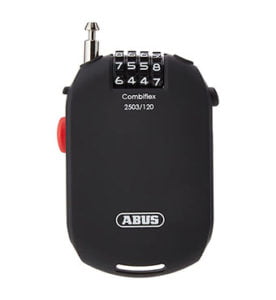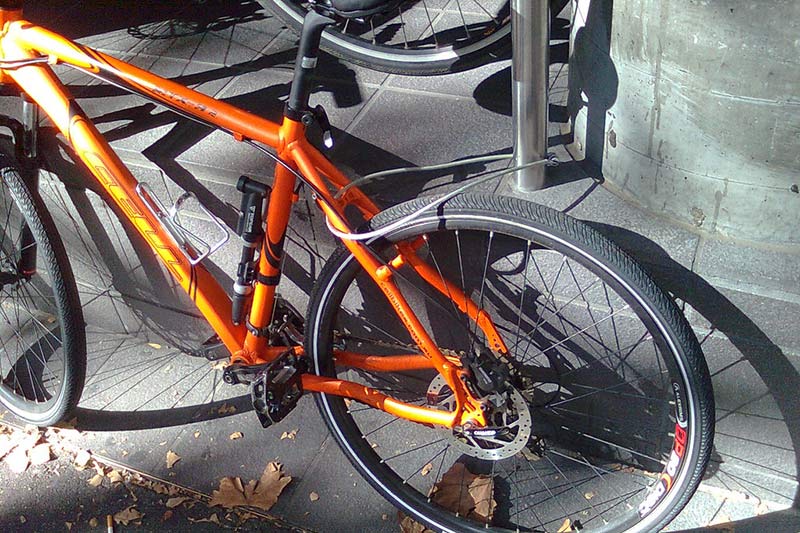There are lots of guides out there that tell you to never use a cable lock.
But this guide isn’t one of them.
I’ll explain in detail below.
Table of Contents
Why I use a (sub £20!) cable lock
I use a cable lock on a weekly basis and I’ve never had my bike stolen while I’ve been using it.
You can buy cable locks that are pretty thick and take a bit of effort to beat with a saw or angle grinder but I don’t even use a particularly strong cable lock. In fact, you could probably beat my lock in under 10 seconds with a decent set of wire-cutting pliers.
My lock doesn’t even have a security-level rating on the manufacturer’s website. They recommend it’s used to lock luggage and similar kit.
Am I some sort of gung-ho maverick? No, not really. I just live in the real-world.
So, you might ask: “What the heck are you doing using one?!”
For me, the main appeal is the ease of use.
I’m in no way saying that a cable lock is the best form of security; it isn’t. In fact, if you look at the videos below, you’ll see cable locks being defeated in seconds.
However, a cable lock is the best lock for me, in the way that I use it.
The theory behind why I use a cable lock
I carry my cable lock with me at all times. It weighs just 90 grams and it stashes perfectly in a side pocket of my rucksack.
It’s a combination lock which mean there’s no faffing around with, forgetting – or losing – keys. I can deploy it in seconds.
When I go to the local bakery on the weekend or I stop for a coffee at one of my favourite coffee shops around down, I use the cable lock.
I try to lock the bike to a fixed object like a post, railing or Sheffield barrier. Perhaps the table or chair that I’m going to sit at.
Yes, it’s easily defeated but it stops the opportunists. Not every bike thief walks around with a set of 42″ bolt-croppers up their sleeve.
Despite lots of videos on YouTube, most bike thieves don’t like to work in public and aren’t comfortable being filmed while they’re pinching a bike. Most like to blend in, so they operate at night or in low-traffic locations.
Yes, some are brazen and will pull out an angle grinder in the middle of Oxford Circus but these are the minority.
I use this lock all the time. If I wheel my bike into someone’s office, I’ll lock my helmet and rucksack to it with the cable lock. When I’m at the local park with my son, I’ll use the cable lock around the wheels and frame if there’s nothing to lock it to.
You might think I’m being lackadaisical but I wouldn’t lean my bike up outside the local coffee shop with no security on it, because any old Tom, Dick or Harry could be off with it in a flash.
However this small cable lock buys you plenty of time and rules out the chancers.
Yes, if I’m locking my bike for a period of time – like when I’m kicking a ball at the local park – I’ll take a sturdier lock. But life’s not perfect. I often leave the house with the best intentions of taking a better lock and realise I have totally forgotten it but my tiny and light Abus is always in my rucksack, ready to go.
Let’s be honest; If I was grabbing a flat white and a pain au raisin, I’d be pretty unlucky to have my bike stolen with this lock in use.
That’s why I use a cable lock and that’s why I think they have a role to play.
Is a thick cable lock secure?
In short, no. Pretty much all cable locks are built using the same method: thin metal wires are twisted around each other to form the cable.
When you buy a cheap cable lock, it uses fewer wires and probably a low-quality metal. You can get thick cable locks, where the main body of the cable is thicker than your thumb, but the fact is this lock is just made up of MORE thin cables. A bolt cropper will just munch through these individual wires with a few big chomps.
If cable locks are so bad, why do people use them?
Cable locks aren’t a good means of primary security. Use one and it’s a case of when your bike gets stolen, not if.
However they’re popular because they’re CHEAP to buy and EASY to use.
Most people who buy one don’t know how easy they are to cut and if you buy one from your local bike shop, you’re probably thinking they’re not going to sell naff locks but rest assured, they do!
Cable locks being defeated in seconds
The videos below show how easy it is to cut a cable lock. They’re definitely not a good means of primary security.https://www.youtube.com/watch?v=SMEQRV_TnbA
In this video, the cable lock puts up a bit more of a challenge because the thief only has a small set of bolt croppers. If you were 10-metres away in a local shop and this guy was trying to nick your bike, you’d be on him in no time.
So as you can see in these videos; cable locks are NOT a good way to secure your bike for any length of time.
They are, however, much better than nothing and a very convenient way to give your bike a quickly applied layer of security for those times when you might have your eye off your bike for a few moments, for example dropping your child off to school or grabbing a coffee in the local coffee shop.
The Cable Lock I Use

I use this Abus Combiflex 2503. It costs under £20 here in the UK and while it doesn’t offer much resistance to a physical attack, it does have many benefits over a heavier bike lock (as I’ve hopefully explained above). It weighs just 90-grams and I can carry it in my rucksack side pocket with ease.
I’m not saying it’s the best lock – far from it! – but it’s one of the best locks for my circumstances. I’ve weighed the risks that I’m likely to encounter while using this lock and I’m comfortable with them.
For me, this lock is proof that you don’t have to lug a 1kg lock around with you all the time..
Sources
Thanks to the following websites who have helped me research and write this guide to cable locks:
Bicycles | Security Services | University of Bristol
